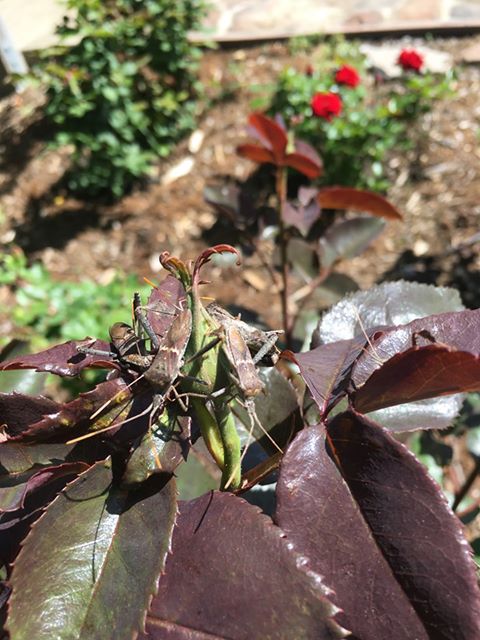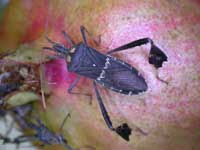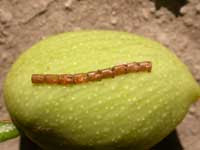
|
|
Reader Irma Hernandez-Larin wanted to know what was eating her roses. Leaf-footed bugs!
(Photo courtesy Irma Hernandez-Larin)
|
Over-wintering adults are laying eggs and making trouble
Be on the lookout: Leaf-footed bugs are already on the attack.

|
|
Leptoglossus zonatus
has become common
in Sacramento. (
Photo courtesy UC IPM)
|
Our mild winter and warm spring brought an early invasion. When not killed by cold, the adults can overwinter in the garden, usually hiding out in tall grasses, wood piles or other protected spaces. When the temperatures turn warm, they come out and start laying eggs.
Those eggs will become the second generation of leaf-footed bugs, sucking the life out of early tomatoes and stone fruit. When we see so many adults in April, June and July could be especially bad.
With distinctive leaf-shaped back legs, the leaf-footed bug is a real stinker; they are closely related to stink bugs. The leaf-footed bug stabs its long mouthparts into nice juicy fruit, flower buds, seeds and other favorite targets, then sucks out the moisture.
Usually found in clusters, the young nymphs seem to appear out of nowhere, climbing over ripening fruit to look for just the right spot to dine. They quickly get big and scary-looking; adults measure more than an inch tall.
Three different species are native to California and they attack a wide range of crops and ornamental plants. The most common in Sacramento is
Leptoglossus zonatus
. Fortunately, damage often is only cosmetic.
In home gardens, they primarily attack tomatoes, pomegranates and roses. They also have a huge appetite for almonds, pistachios, citrus and watermelon. But
L. zonatus
is opportunistic; it eats lots of different fruit, vegetables, nuts and flowers.
Leaf-footed bugs tend to hang out and breed in weedy areas (they love thistles) before moving into the tomato patch. (That’s another reason to keep weeds down.)
Catch these bad bugs while they’re young. The nymphs move slowly and can’t fly.
Knock them off into a bucket of water; add a teaspoon of liquid detergent to the water to assure a quick demise. No pesticides are necessary. But wear gloves; if touched, these bugs will make your hands stink.
During a previous leaf-footed bug invasion, I asked Sacramento's Bug Man – retired state entomologist Baldo Villegas – for his advice. Right now, watch for their distinctive eggs as well as the nymphs and adults. The eggs look like a tiny amber bracelet. (If you see these bug eggs, pick the leaf and destroy it, eggs and all.)

|
Leaf-footed bug eggs look like an itty-bitty
amber bracelet. (Photo courtesy UC IPM)
|
“The females generally lay groups of shiny golden eggs on leaves of host trees,” Villegas said. “The eggs hatch usually about the same time, and they generally feed in groups as there is usually a pheromone that keeps the group together. This is also a clue to how to control them.”
What does he do when he sees these bugs? Shake them off the bush.
“I consider these bugs a nuisance pest rather than a garden pest as one can easily control them by just shaking them into a bucket containing soapy water,” he said. “Once the bugs hit the soapy water, they usually drown.”
Leaf-footed bugs can produce multiple generations each summer, so more nymphs may pop up at any time after May. One overwintering adult can lay up to 200 eggs in April and early May. The eggs take a week to hatch, but then the flightless nymphs hang around for six to eight weeks.
For more on these pests, check out these recommendations from the UC Cooperative Extension Pest Notes:
http://ipm.ucanr.edu/PMG/PESTNOTES/pn74168.html



